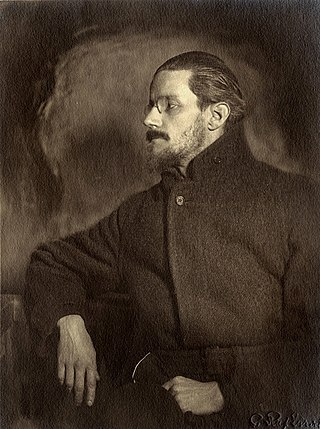
James Augustine Aloysius Joyce was an Irish novelist, poet and literary critic. He contributed to the modernist avant-garde movement and is regarded as one of the most influential and important writers of the 20th century. Joyce's novel Ulysses (1922) is a landmark in which the episodes of Homer's Odyssey are paralleled in a variety of literary styles, particularly stream of consciousness. Other well-known works are the short-story collection Dubliners (1914), and the novels A Portrait of the Artist as a Young Man (1916) and Finnegans Wake (1939). His other writings include three books of poetry, a play, letters, and occasional journalism.
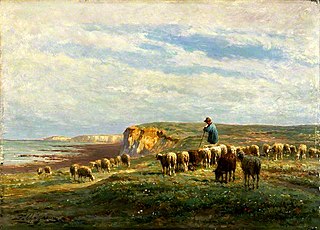
A villanelle, also known as villanesque, is a nineteen-line poetic form consisting of five tercets followed by a quatrain. There are two refrains and two repeating rhymes, with the first and third lines of the first tercet repeated alternately at the end of each subsequent stanza until the last stanza, which includes both repeated lines. The villanelle is an example of a fixed verse form. The word derives from Latin, then Italian, and is related to the initial subject of the form being the pastoral.

Ulysses is a modernist novel by the Irish writer James Joyce. Parts of it were first serialized in the American journal The Little Review from March 1918 to December 1920, and the entire work was published in Paris by Sylvia Beach on 2 February 1922, Joyce's fortieth birthday. It is considered one of the most important works of modernist literature and has been called "a demonstration and summation of the entire movement". According to the writer Declan Kiberd, "before Joyce, no writer of fiction had so foregrounded the process of thinking".
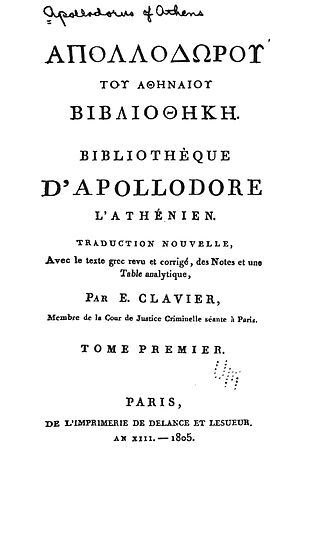
The Bibliotheca, also known as the Bibliotheca of Pseudo-Apollodorus, is a compendium of Greek myths and heroic legends, arranged in three books, generally dated to the first or second century AD.

Leopold Bloom is the fictional protagonist and hero of James Joyce's 1922 novel Ulysses. His peregrinations and encounters in Dublin on 16 June 1904 mirror, on a more mundane and intimate scale, those of Ulysses/Odysseus in Homer's epic poem: The Odyssey.
Non serviam is Latin for "I will not serve".

A Portrait of the Artist as a Young Man is the first novel of Irish writer James Joyce, published in 1916. A Künstlerroman written in a modernist style, it traces the religious and intellectual awakening of young Stephen Dedalus, Joyce's fictional alter ego, whose surname alludes to Daedalus, Greek mythology's consummate craftsman. Stephen questions and rebels against the Catholic and Irish conventions under which he has grown, culminating in his self-exile from Ireland to Europe. The work uses techniques that Joyce developed more fully in Ulysses (1922) and Finnegans Wake (1939).

Stephen Dedalus is James Joyce's literary alter ego, appearing as the protagonist and antihero of his first, semi-autobiographic novel of artistic existence, A Portrait of the Artist as a Young Man (1916), and as a major character in his 1922 novel Ulysses. Stephen mirrors many facets of Joyce's own life and personality. Joyce was a talented singer, for example, and in Ulysses Leopold Bloom notes the excellence of Stephen's tenor voice after hearing him sing Johannes Jeep's song "Von der Sirenen Listigkeit".

Dubliners is a collection of fifteen short stories by James Joyce, first published in 1914. It presents a naturalistic depiction of Irish middle class life in and around Dublin in the early years of the 20th century.

Molly Bloom is a fictional character in the 1922 novel Ulysses by James Joyce. The wife of main character Leopold Bloom, she roughly corresponds to Penelope in the Odyssey. The major difference between Molly and Penelope is that while Penelope is eternally faithful, Molly is not. Molly is having an affair with Hugh 'Blazes' Boylan. Molly, whose given name is Marion, was born in Gibraltar on 8 September 1870, the daughter of Major Tweedy, an Irish military officer, and Lunita Laredo, a Gibraltarian of Spanish descent. Molly and Leopold were married on 8 October 1888. She is the mother of Milly Bloom, who, at the age of 15, has left home to study photography. She is also the mother of Rudy Bloom, who died at the age of 11 days. In Dublin, Molly is an opera singer of some renown.
The Society of Biblical Literature (SBL), founded in 1880 as the Society of Biblical Literature and Exegesis, is an American-based learned society dedicated to the academic study of the Bible and related ancient literature. Its current stated mission is to "foster biblical scholarship". Membership is open to the public and consists of over 8,300 individuals from over 100 countries. As a scholarly organization, SBL has been a constituent society of the American Council of Learned Societies since 1929.
Malachi Roland St. John "Buck" Mulligan is a fictional character in James Joyce's 1922 novel Ulysses. He appears most prominently in episode 1 (Telemachus), and is the subject of the novel's famous first sentence: "Stately, plump Buck Mulligan came from the stairhead, bearing a bowl of lather on which a mirror and a razor lay crossed."

Leonard Alfred George Strong was a popular English novelist, critic, historian, and poet, and published under the name L. A. G. Strong. He served as a director of the publishers Methuen Ltd. from 1938 to 1958.
The Countess Cathleen is a verse drama by William Butler Yeats in blank verse. It was dedicated to Maud Gonne, the object of his affections for many years.
Robert Greacen (1920–2008) was an Irish poet and member of Aosdána. Born in Derry, Ireland, on 24 October 1920, he was educated at Methodist College Belfast and Trinity College Dublin. He died on 13 April 2008 in Dublin, Ireland.
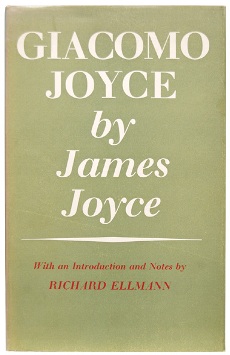
Giacomo Joyce is a posthumously-published work by Irish writer James Joyce. It was published by Faber and Faber from sixteen handwritten pages by Joyce. The text is a free-form love poem that tracks the waxing and waning of Joyce's infatuation with one of his students in Trieste.
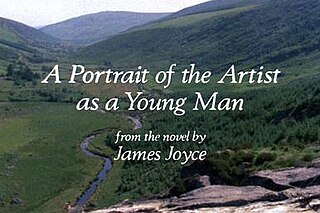
A Portrait of the Artist as a Young Man is a 1977 film adaptation of Irish novelist James Joyce's 1916 novel of the same name, directed by Joseph Strick. It portrays the growth of consciousness of Joyce's semi-autobiographical character, Stephen Dedalus, as a boy and later as a university student in late nineteenth-century Dublin.
Epiphany in literature refers generally to a visionary moment when a character has a sudden insight or realization that changes their understanding of themselves or their comprehension of the world. The term has a more specialized sense as a literary device distinct to modernist fiction. Author James Joyce first borrowed the religious term "Epiphany" and adopted it into a profane literary context in Stephen Hero (1904–1906), an early version of A Portrait of the Artist as a Young Man. In that manuscript, Stephen Daedalus defines epiphany as "a sudden spiritual manifestation, whether in the vulgarity of speech or of gesture or in a memorable phase of the mind itself." Stephen's epiphanies are moments of heightened poetic perception in the trivial aspects of everyday Dublin life, non-religious and non-mystical in nature. They become the basis of Stephen's theory of aesthetic perception as well as his writing. In similar terms, Joyce experimented with epiphany throughout his career, from the short stories he wrote between 1898 and 1904 which were central to his early work, to his late novel Finnegans Wake (1939). Scholars used Joyce's term to describe a common feature of the modernist novel, with authors as varied as Virginia Woolf, Marcel Proust, Ezra Pound, and Katherine Mansfield all featuring these sudden moments of vision as an aspect of the contemporary mind. Joycean or modernist epiphany has its roots in nineteenth-century lyric poetry, especially the Wordsworthian "spots of time," as well as the sudden spiritual insights that formed the basis of traditional spiritual autobiography. Philosopher Charles Taylor explains the rise of epiphany in modernist art as a reaction against the rise of a “commercial-industrial-capitalist society” during the early twentieth century.
John Jermain Slocum (1914–1997) was an American diplomat, book collector, literary agent, and scholar. He spent most of his career in the Inspection Corps of the United States Information Agency. As a bibliophile and philanthropist, he influenced two major US archives and contributed to scholarship on James Joyce.












